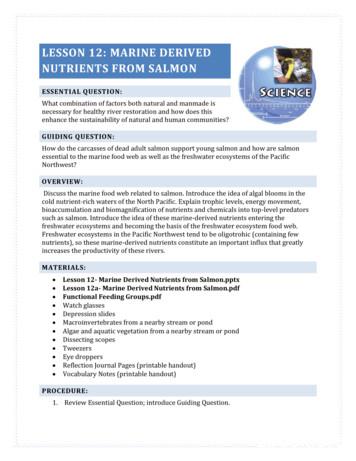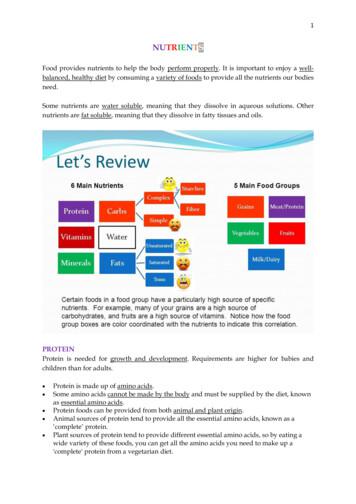Lesson 12: Marine Derived Nutrients From Salmon
LESSON 12: MARINE DERIVEDNUTRIENTS FROM SALMONESSENTIAL QUESTION:What combination of factors both natural and manmade isnecessary for healthy river restoration and how does thisenhance the sustainability of natural and human communities?GUIDING QUESTION:How do the carcasses of dead adult salmon support young salmon and how are salmonessential to the marine food web as well as the freshwater ecosystems of the PacificNorthwest?OVERVIEW:Discuss the marine food web related to salmon. Introduce the idea of algal blooms in thecold nutrient-rich waters of the North Pacific. Explain trophic levels, energy movement,bioaccumulation and biomagnification of nutrients and chemicals into top-level predatorssuch as salmon. Introduce the idea of these marine-derived nutrients entering thefreshwater ecosystems and becoming the basis of the freshwater ecosystem food web.Freshwater ecosystems in the Pacific Northwest tend to be oligotrohic (containing fewnutrients), so these marine-derived nutrients constitute an important influx that greatlyincreases the productivity of these rivers.MATERIALS:Lesson 12- Marine Derived Nutrients from Salmon.pptxLesson 12a- Marine Derived Nutrients from Salmon.pdfFunctional Feeding Groups.pdfWatch glassesDepression slidesMacroinvertebrates from a nearby stream or pondAlgae and aquatic vegetation from a nearby stream or pondDissecting scopesTweezersEye droppersReflection Journal Pages (printable handout)Vocabulary Notes (printable handout)PROCEDURE:1. Review Essential Question; introduce Guiding Question.
2. Students should take a few minutes to respond to the first reflection prompts.Discuss their answers and any questions they’ve generated.3. Hand out the Vocabulary Notes. With this lesson you may want to define the wordsbefore presenting the PowerPoint Lesson.4. Present the PowerPoint Lesson. Check nexpideaforrivstudy1.htm forsome fun language arts lessons to help students identify microinvertebrates.5. Macroinvertebrate Lab Activity6. Hand out the second Reflection Journal Page. Give students time for a final reflectionthe lesson.ASSESSMENTS:WASHINGTON STATE STANDARDSSCIENCE1. EALR 4: 6-8 LS2A An ecosystem consists of all the populations living within aspecific area and the nonliving factors they interact with. One geographical area maycontain many ecosystems.a. Explain that an ecosystem is a defined area that contains populations of organismsand nonliving factors.b. Give examples of ecosystems (e.g., Olympic National Forest, Puget Sound, onesquare foot of lawn) and describe their boundaries and contents.2. EALR 4: 6-8 LS2B Energy flows through an ecosystem from producers (plants) toconsumers to decomposers. These relationships can be shown for specific populationsin a food web.a. Analyze the flow of energy in a local ecosystem, and draw a labeled food webshowing the relationships among all of the ecosystem’s plant and animalpopulations.READING1. EALR 1: The student understands and uses different skills and strategies to read.a. Component 1.2 Use vocabulary (word meaning) strategies to comprehend text.i. 1.2.1 Understand and apply dictionary skills and other reference skills.ii. 1.2.2 Apply a variety of strategies to comprehend words and ideas in complextext.SOCIAL STUDIES1. EALR 5: The student understands and applies reasoning skills to conduct research,deliberate, form, and evaluate positions through the processes of reading, writing,and communicating.
a. Component 5.2: Uses inquiry-based research.i. 5.2.1 Creates and uses research questions to guide inquiry on an issueor event.WRITING1. EALR 2: The student writes in a variety of forms for different audiences andpurposes.a. Component 2.1: Adapts writing for a variety of audiences.i. 2.2.1 Demonstrates understanding of different purposes for writing.1. Writes to learn (double-entry journal in math, social studies, orscience; letter to teacher assessing own work; reflection).ADDITIONAL RESOURCES AND ZooGoer/2004/1/Pacific Salmon.cfm
VOCABULARY TERMS:Shredder- Eat leaves and other vegetative particles and select those with fungi andbacteria attached to them for protein (includes mayfly and caddisfly larva).Scraper/Grazers- Scrape biofilm, algae, and detritus from rocks, wood, and vegetation(includes snails and caddisfly larva)Filter-feeder- Filter small particles out of the water-column, often dislodged by theshredders and scrapers (includes copepods, amphipods, blackfly and midge larva,hydra, etc.).Collector-gatherer- Forage along the streambed for detritus, food particles, and fungi(includes stonefly larva and some mayfly larva).Predator- An organism that hunts and feeds on other animals (includes dragonflylarva, water beetles, water striders, etc.)Biofilm- A community of microorganisms living within a matrix of secreted materialssecured to a solid structure such as river rocks or aquatic vegetation. They are oftencomplex environments containing bacteria, algae, fungi, and protozoans.Marine-derived nutrients (MDN)- Nutrients acquired by an anadromous fish anddeposited in a freshwater or terrestrial ecosystem when that fish dies.Oligotrophic- Containing few nutrients and therefore unable to support much life
Eutrophic- An ecosystem containing high levels of nutrients and therefore supportinghigh productivity. However, an overly eutrophic environment can result in algal bloomsthat cause the waters to become deficient in oxygen through the bacterial consumptionof dying algae. These anoxic aquatic environments can then become dead zones to allbut algae.Nutrient cycle-Transfer of NUTRIENTS from one part of an ecosystem to another.Saprophyte- An organism, especially a fungus or bacterium, that grows on and derivesits nourishment from dead or decaying organic matter.
Elwha River RestorationMarine Derived Nutrients from SalmonReflection Journal 1How can a dead animal be part of a healthy ecosystem?What questions do you have about dead animals in the ecosystem?
Elwha River RestorationMarine Derived Nutrients from SalmonVocabulary tor-gatherer:Predator:Biofilm:Marine-derived nutrients (MDN):Oligotrophic:
Eutrophic:Nutrient cycle:Saprophyte:
Elwha River RestorationMarine Derived Nutrients from SalmonReflection Journal 1How do the carcasses of dead adult salmon support young salmon, and how are salmonessential to the marine food web as well as the freshwater ecosystems of the PacificNorthwest?What questions do you have about salmon, the marine food web, or the freshwaterecosystems of the Pacific Northwest?
LAB ACTIVITYIn the Macroinvertebrate Lab you will collect aquatic insects and other macroinvertebratesfrom a local stream. They can be stored overnight in a refrigerator. Most organismscollected in nearby streams and ponds in North America will be similar to those in theElwha River. Have the students examine them under the microscopes, key them out to agroup or class of organisms (genus or family if possible), and identify the functional feedinggroup they belong to. Click on the side below to open the pdf.ADDITIONAL LAB RESOURCES:http://people.virginia.edu/ dy.HTML**Some fun Language arts activities to help students identify Aquatic insects andmicroinvertebratesGo to benthic language arts lessons from Rivers ts/inexpideaforrivstudy1.htm
Marine-derived nutrients (MDN)-Nutrients acquired by an anadromous fish and deposited in a freshwater or terrestrial ecosystem when that fish dies. Oligotrophic- Containing few nutrients and therefore unable to support much life . Eutrophic- An ecosystem containing high levels of nutrients and therefore supporting
4 Step Phonics Quiz Scores Step 1 Step 2 Step 3 Step 4 Lesson 1 Lesson 2 Lesson 3 Lesson 4 Lesson 5 Lesson 6 Lesson 7 Lesson 8 Lesson 9 Lesson 10 Lesson 11 Lesson 12 Lesson 13 Lesson 14 Lesson 15 . Zoo zoo Zoo zoo Yoyo yoyo Yoyo yoyo You you You you
Lesson 2: Nutrients We Need 29 2. Nutrients We Need. OBJECTIVES . To emphasize the similarities between humans and plants in the need for nutrients To learn about the six classes of nutrients and why we need all six of them To learn how to identify good food sources of selected nutrients To learn how plants provide us with nutrients
Participant's Workbook Financial Management for Managers Institute of Child Nutrition iii Table of Contents Introduction Intro—1 Lesson 1: Financial Management Lesson 1—1 Lesson 2: Production Records Lesson 2—1 Lesson 3: Forecasting Lesson 3—1 Lesson 4: Menu Item Costs Lesson 4—1 Lesson 5: Product Screening Lesson 5—1 Lesson 6: Inventory Control Lesson 6—1
NUTRIENTS Food provides nutrients to help the body perform properly. It is important to enjoy a well-balanced, healthy diet by consuming a variety of foods to provide all the nutrients our bodies need. Some nutrients are water soluble, meaning that they dissolve in aqueous solutions. Other
Manure contains both macro- and micro-nutrients needed for crop production in organic and inorganic forms. Inorganic nutrients are readily available to the growing crop, while the organic nutrients become available gradually over time. A crop responds to inorganic nutrients in soil, whether they originate from manure or commercial fertilizer.
Module - Classes of Nutrients Learning Objectives Beginner List the five classes of nutrients. Identify common sources for each nutrient. Intermediate Explain functions of common nutrients in horses. Discuss the difference between micro- and macro-nutrients. Seniors Discuss the concept of "most limiting nutrient."
Lesson 41 Day 1 - Draft LESSON 42 - DESCRIPTIVE PARAGRAPH Lesson 42 Day 1 - Revise Lesson 42 Day 1 - Final Draft Lesson 42 - Extra Practice LESSON 43 - EXPOSITORY PARAGRAPH Lesson 43 Day 1 - Brainstorm Lesson 43 Day 1 - Organize Lesson 43 Day 1 - Draft LESSON 44 - EXPOSITORY PARAGRAPH Lesson 44 Day 1 - Revise
ASTM D 4255 SACMA RM 3 ASTM D 5766 ASTM 2344 ASTM 2584 ASTM 1622 ASTM D 2734 ASTM D 570 5 5 5 5 5 5 5 5 5 5 5 5 5 5 5 5 5 5 5 5 5 1 1 1 1 1 45 45 45 45 45 45 45 3 3 3 3 3 CTD – Cold Temperature Dry (-29C) RTA – Room Temperature Ambient ETW – Elevated Temperature Wet (Equilibrium Conditioning - 95% RH and 49C) Three batches (minimum) per test. A batch consists of laminates fabricated on .























